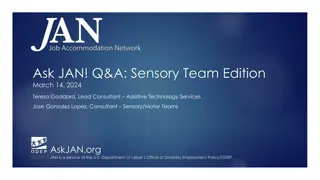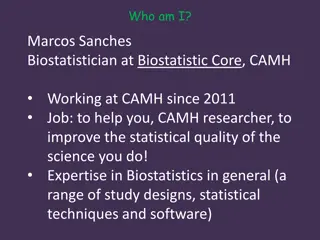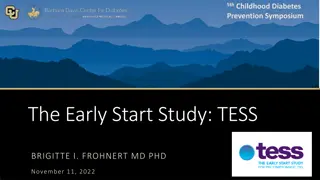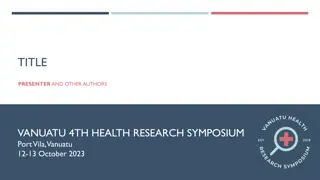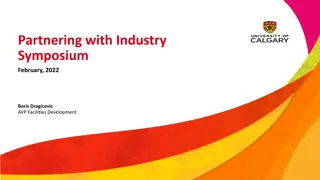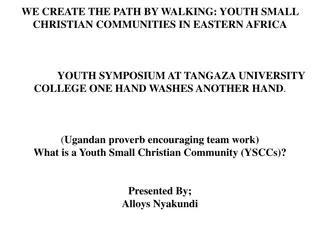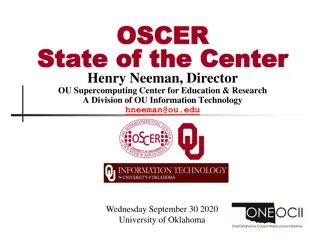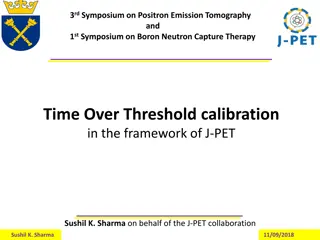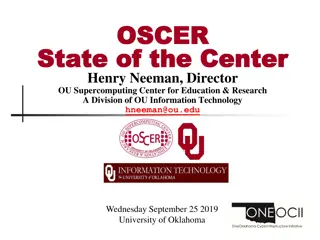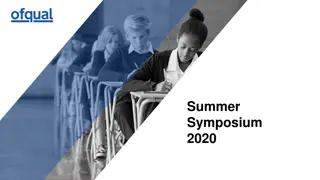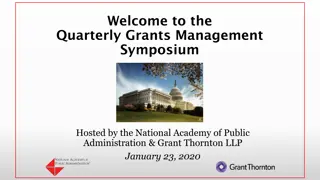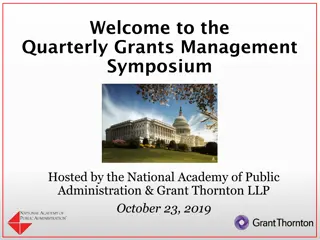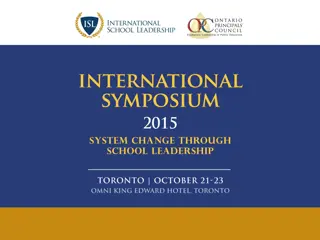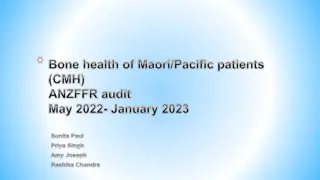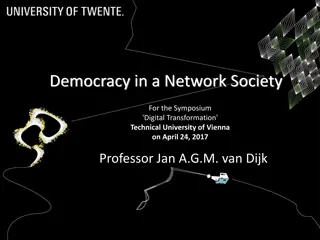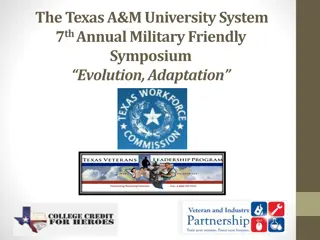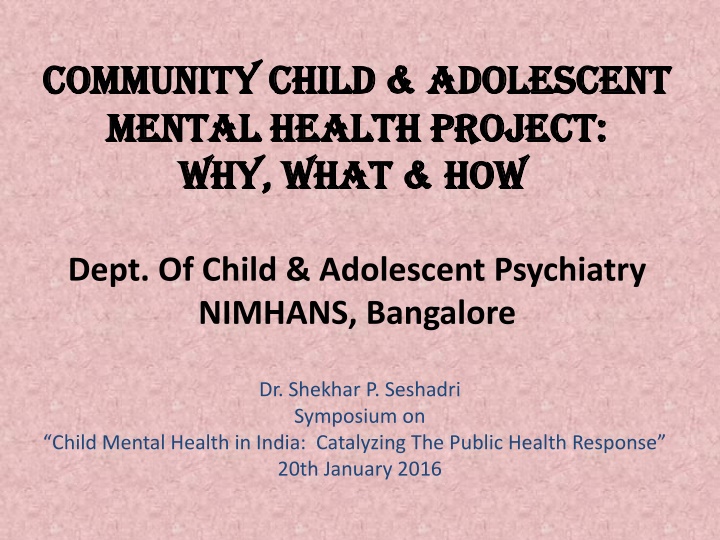
Community Child & Adolescent Mental Health Project Overview
Explore the initiatives of the Community Child & Adolescent Mental Health Project at NIMHANS, Bangalore, focusing on the need for improved access to mental health services for vulnerable children. The project includes needs assessment, resource mapping, and the establishment of community-based services, all geared towards enhancing mental health support for children and adolescents in India.
Download Presentation

Please find below an Image/Link to download the presentation.
The content on the website is provided AS IS for your information and personal use only. It may not be sold, licensed, or shared on other websites without obtaining consent from the author. If you encounter any issues during the download, it is possible that the publisher has removed the file from their server.
You are allowed to download the files provided on this website for personal or commercial use, subject to the condition that they are used lawfully. All files are the property of their respective owners.
The content on the website is provided AS IS for your information and personal use only. It may not be sold, licensed, or shared on other websites without obtaining consent from the author.
E N D
Presentation Transcript
Community Child & Adolescent Community Child & Adolescent Mental Health Project: Mental Health Project: Why, What & How Why, What & How Dept. Of Child & Adolescent Psychiatry NIMHANS, Bangalore Dr. Shekhar P. Seshadri Symposium on Child Mental Health in India: Catalyzing The Public Health Response 20th January 2016
Why Community Child Mental Health? Limited access to mental health services esp. for children low socio-economic families and communities. Children in difficult circumstances are especially vulnerable to mental health morbidity and have poor access to services. Poor community awareness on child mental health needs and services. Few child mental health care services/ service providers. Mental health services concentrated in tertiary care facilities. Gaps in mental health knowledge and skills of child care service providers. The need to integrate child mental health services into child care services in health/education/welfare sectors to enhance access and coverage. Preventive/promotive child mental health services required for minimizing child mental health morbidity. Curative child mental health services children s right to assistance.
Preliminary Work: Needs Assessment & Resource Mapping of Community Services Needs assessment (June to September 2014) through R.N. Moorthy Foundation support In-depth interviews and focus group discussions with (including provision of awareness/ sensitization workshops on child mental health to): Service providers in government Depts. of Health, Education and Welfare PHCs, Anganwadis, child care institutions (govt. & NGO), government schools and government schemes such as RBSK Needs assessment objectives: identify the types of services provided by the agency/service; understand child mental health issues in the community assess the capacity needs and gaps of the service providers. Detailed report available on needs assessment findings & project interventions/ services developed based on these.
Objectives Establishment of community-based child and adolescent services. Training and capacity building of childcare workers and staff from various governmental and non-governmental agencies, including schools. Develop a comprehensive community child and adolescent mental health service model that may be replicated elsewhere in the country.
Principles & Technical Approach Universal access to child (mental) healthcare Equitable coverage (with focus on vulnerable children and adolescents) Community involvement and participation to ensure sustainability Adoption of multi-sectional approach through involvement of various sectors such as health, education, women and child welfare.
Where? Criteria for Selection of Child care agencies and service providers located in Bangalore south zone: i) PHCs with catchment area being inclusive of at least one slum population (preferably a larger slum area); ii) PHC catchment area having within or near it, at least one government school that is attended by children from the slum. iii) Government schools iv) Anganwadis located within or nearest to slum/ vulnerab;e populations v) Govt. & non-govt. child care institutions located all over Bangalore city (those serving children in difficult circumstances).
What and How? Where/ For Whom Services Provided Screening for disability & other child mental health problems in health campaigns/ on immunization days. Assessment (& provisional diagnosis) of children identified by teachers as having emotional/ behavioural learning problems Provision of first level responses to children & families Early screening/identification/ intervention for disability Early stimulation work demonstration for/ discussion with teachers Assessment (& provisional diagnosis) of children identified by teachers as having emotional/ behavioural learning problems Provision of first level responses to children How teachers can provide support to children Training teachers in classroom remedial education Primary Healthcare Centres Anganwadis Schools
What and How? (Cont...) Where/ For Whom Services Provided Assessment (& provisional diagnosis) of children identified by staff as having emotional/ behavioural learning problems Provision of context-specific first level responses to children Implementation of life skills (group) sessions How institution staff can provide support to children Child Care Institutions All Institutions Training & Capacity Building: Orientations, symposiums, Participatory/ Skill Building Workshops Advocacy/ Systems Work Documentation & Material Development training manuals & handbooks for service providers; activity books/methods for use with children for field workers. *Mild-moderate problems managed on field/ with agencies. Severe problems referred to tertiary care facilities/ NIMHANS.
2014-15 in a Nutshell...Achievements & Coverage 56 43 14 11 124 No. of Institutions/ Agencies Reached Government (and Aided) Schools Anganwadis Primary Health Centres Child Care Institutions Total Types of Agencies/ Services Schools PHC Anganwadi CCI No. of Children Reached Individual Services 504 845 0 94 1,4 43 Group Services 70 0 671 403 Total 574 845 671 497 Total 1,144 2,587 925 Training and Capacity Building No. of (Individual) Service Providers Oriented/Trained No. of Agencies/ Centres Represented by these Service Providers No. of Districts 311 43 (+ 4 countries) other than India)
What We Know So Far... Experiences & Insights from our Community Child Mental Health Services
Primary Healthcare Centres Community mobilization by the link workers is extremely variable; in most cases, community mobilization was extremely poor. Link workers, despite having attended orientation workshops are unable to transfer house-tohouse messages. Systemic issues: over-burdened link workers/ poorly remunerated Now, system transitioning to ASHA workers...incentive-based community health programs, so hard for child mental health agenda to be a priority (competing with other vertical programs). Medical Officers were frequently absent/ unavailable. Perception that the service was to be run by the NIMHANS project team-- therefore an attitude that the PHC did not need to participate or learn i.e. a lack of understanding of the objectives of integrating child mental health into primary healthcare services. Can we Integrate Child Mental Health into PHC Services? There is scope & potential...but where is the interest & will to work? Only strong leadership (ANMs and/or MOs) can make it happen... Where does the District Mental Health Program feature??
Schools Anxiety common emotional problem: social anxiety marital conflicts/alcohol dependency/ family issues in children s homes; learning problems/fears children experience in the classroom due to the teacher s expectations. ADHD alone accounts for about half the behaviour disorders reported. Anger and aggression issues are also frequently occurring conduct symptoms. Several children with mild intellectual disability (RTE Act) although schools have not the knowledge/ skills to guide them. Learning difficulties common problem, due not only to SLD but due to under-stimulation, migration of families/ change in medium of instruction...
What you said that day, on the first day [helped me] : The Impact of First Level Response in School 87% of children with anxiety reported that they were (partially or wholly) implementing the interventions suggested in the first level response. Nearly half these children reported greater than 51% improvement 90% of children with anger/ aggression implemented interventions and nearly 40% of them reported high levels of improvement. 80% of ADHD children report improvement with over half of them reporting between 26 and 50% improvement and nearly a third of them reporting over 51% improvement. Overall, 76% reported that they were (at least to some extent) implementing the interventions suggested during counselling sessions and 38% of the children reported higher levels of improvement. Only 43% of teachers report that they implement interventions . Younger children (& those with intellectual disability) need more external support/ find it harder to remember & implement activities for healing. Teachers interest and motivation to support and assist children (?)
Innovative Experiment in Schools...Meeting the Needs of Children with Learning Difficulties Development of a model for remedial education Pilot: 10 (volunteer) schools Orientation of teachers on children s learning problems On-the-job classroom training of teachers in use of remedial techniques as applicable in low resource settings/ govt. Schools
Anganwadis Anganwadi teachers still feel that early childcare/ child health is only about adequate nutrition i.e. they find it difficult to perceive the role that early stimulation and pre-school education plays in child development and health. Perception that the pre-school education activities are not their responsibility: you are coming, so you do the activities. Anganwadis have a considerable amount of play materials for pre- school activities but are unwilling to use them the teachers fear breakage and destruction of materials. Anganwadi teachers ways of engaging with the children are largely in a disciplinary context, generally in a mode that is instructive rather than playing, dialoguing or conversing with the children/ not within child development activity framework. One of the most difficult child care service providers to motivate (also poorly remunerated/ systemic problems of over-loading). Neglect of pre-school developmental activities/ education leads to children not having readiness skills required for schools therefore high incidence of learning difficulties in schools.
Child Care Institutions Categories: i. Orphan & abandoned children ii. Street & working children iii. HIV infected/ affected children iv. Disabled children v. Children affected by gender & sexuality vulnerabilities incl. trafficking vi. Children in conflict with the law Contexts: a) Institutionalized children b) Non-institutionalized children Spaces: Communities (within families from low socio-economic strata) Observation Homes/Remand Homes/Transitional shelters/State and NGO Residential homes Bus-stands/Railway Stations, Streets, Raid-Rescue spaces (trafficking)
Experiences: Single parent families Rejection & abandonment Parental marital conflict Loss & Grief (Death of Parents and/or other Attachment Figures) Alcohol dependency in parents Parent with mental illness/ disability Physical, sexual and emotional abuse (violence). Child labour and trafficking Conflict with the law Political violence (ethnic cleansing/ genocide/ communal conflicts) Illness and disability
Emotional & Behavioural Consequences Internalizing Disorders: Anxiety (incl. dissociative disorders, bed-wetting) Adjustment Disorders/Dysphoria/ Depression PTSD Externalizing Disorders: Runaway behaviour Self-harm Anger/ aggression Substance abuse Life Skills Issues Sex and sexuality issues Bullying (perpetration and victim) *Poor Emotional Regulation also the underlying reason for many emotional & behaviour problems in vulnerable children * Poor problem solving and conflict resolution skills also the underlying reason for conduct problems & high risk behaviours in vulnerable children
The Basis of Vulnerable Childrens Mental Health Problems: Loss of Childhood 1. Attachment issues and Neglect (Acts of Omission) The families and home environments of these children are frequently fraught with marital problems, domestic violence, alcohol dependence Single-parenting, lack of time on the part of the parent to care for the child (usually due to financial problems and the need to work long hours outside the home). Lack of early stimulation opportunities/ activities for holistic child development. 2. The Trauma of Abuse(Acts of Commission) Early experiences of neglect, emotional, physical, sexual abuse. 3. The Trauma of Loss (including illness/ disablity) In later years, when the child comes to the institution, the attachment with the family (whatever the quality of attachment) is severed by physical separation, which may occur in various ways (such as rejection, abandonment, or relinquishment to an institution). 4. Difficulty Re-establishing Attachment Multiple changes in institution and changes in care givers due to staff turn-over within these institutions also contribute hugely to children s destabilizing experiences and do not allow them to easily find suitable (substitute) attachment figures as they move through life.
The trauma of loss & abuse is a cross-cutting theme but some are more equal than others HIV disclosure, adherence and mortality Children with disability: identity, personhood and rights Children in conflict with the law: social exclusion/ rejection and retribution versus restorative justice infected/ affected children: Illness,
Expanding Methods of Work with Disabled Children Meeting the educational needs (and rights) of disabled children in care & protection institutions How to use existing resources/ staff and train them in special education techniques/ child development/ disability-related work so that orphan, abandoned, disabled children receive schooling & life skills education Special emphasis on socio-emotional development, incl. personal safety for children with disability
Training & Capacity Building Focus on skill building: Identifying the specificity of contexts of children s issues/ responses Basic communication techniques with children Use of creative methods for healing Dealing with systems Our approach: Participatory methods/ do and learn Films, case studies, role plays Some Specific Areas of Training... Trauma Work: Child sexual abuse, Loss & Grief, Children in war/ Conflict Working with HIV Infected/ Affected Children School Mental Health Working with Pre-Schoolers Children & Disability Children in Conflict with the Law Children in trafficking Continual experimentation with new pedagogies and methods to re-align ourselves to the needs of varied professionals/ needs/ contexts
Advocacy & Systems Work...Some Examples Child Sexual Abuse: Response to Child Safety Policy & mental health being non-negotiable principle; advocating for strong response protocol along with DWCD. Enabling children in child care institutions to avail of services (such as schooling for children with disability) Developing a health response protocol to be institutionalized in child care agencies (care & protection). Children in Conflict with the Law: Position-taking on new JJ amendment & criminal culpability based on brain maturity, issue of proportionality & restorative justice
Development of Materials Target (Service Provider) Primary Health Centre Materials for Use o Pamphlets on Common Child Mental Health Disorders o Flip Chart on Early Child Development & Stimulation o Flip Chart on Early Child Development & Stimulation o Pre-School Development Activity Book for Teachers o Module on Child Sexual Abuse Prevention for Pre-schoolers o Training manual for Pre-School Teachers o Pamphlets on Common Child Mental Health Disorders o Handbook on 1stLevel Response to Common Child Mental Health Problems o Handbook on Classroom Remedial Techniques in Low Resource Settings o Training manual for school teachers Anganwadi School o Child Care Institutions / CCI (All/ General) Activity Books on Life Skills Education (Emotional Well-Being/ Motivation & Truancy/ Sex & Sexuality/ Substance Abuse) + Games & Illustrated Stories Activity Book on Child Sexual Abuse (Healing & Recovery) Training manual for child care institution staff Handbook on Counselling HIV Infected/ Affected Children Training manual for ART counselors Additional life skills modules on Conduct Issues Training manual for Service Providers Handbook on Schooling & Education for Institutionalized Disabled Children Training manual for Service Providers o o o o o o o o CCI/ HIV-Children CCI/ Children in Conflict with the Law CCI/ Disability
Collaborations & Partnerships Karnataka Health Promotion Trust (HIV infected/ affected children s work) Staff Secondment & training Capacity building for ART counselors. Development of training/ activity materials for use with HIV infected/ affected children. Justice & Care (child trafficking issues) Direct assistance to affected/ vulnerable children in child care institutions Preparation of a mandatory mental health assessment protocol document (to be institutionalised within the state care institutions). Capacity building initiatives and training workshops Rashtriya Bal Swasthya Kendra (RBSK School Health Program) Early and more accurate identification and referral of children with developmental disabilities and other emotional/ behaviour disorders; The extension of the RBSK school health teams roles in the area of child mental health issues (including disability) in ways that enable them to provide first-level responses to children with emotional and behaviour problems, including parent and teacher guidance on home-based care and training for children with disability. Association for People with Disability Support to early intervention centre & school for disability Training/ support for community outreach programs ...in addition to government departments and individual agencies (schools/ anganwadis/PHCs/ child care institutions/NGOs
Operational Challenges Delays due to Lengthy Bureaucratic Procedures Lack of Recognition of Child Mental Health as a Priority (Service Providers & Communities) Limited Understanding of Preventive and Promotive versus Curative Child Mental Health Attitudinal Issues (Service Providers) Barriers to Accessing (Tertiary) Mental Health Care (Communities) The Perception that Good Intention is Sufficient Human resource availability & skills for project implementation Management of transport & logistics on a service- heavy project (constant planning & re-planning due to reflect community plans/ events/ festivals...)
What Next...in 2016? Continued & intensive focus on children in difficult circumstances: Interventions with children in conflict with the law in observation homes/ special homes. Assistance to children in trafficking through NGOs/ care & protection homes. Continue work with HIV infected/ affected children and children with disability Training & Capacity Building RBSK Training for Karnataka teams NGOs/ICPS staff training continued Development of Materials Community awareness pamphlets Handbooks for counsellors & child care service providers Training manuals Life skill and other activity books for use with children
Acknowledgements Dept. Of Women & Child Development, Govt. Of Karnataka Dept. of Education Dept. of Health BBMP NGOs Targeted schools, anganwadis, PHCs, government & non-government child care institutions

